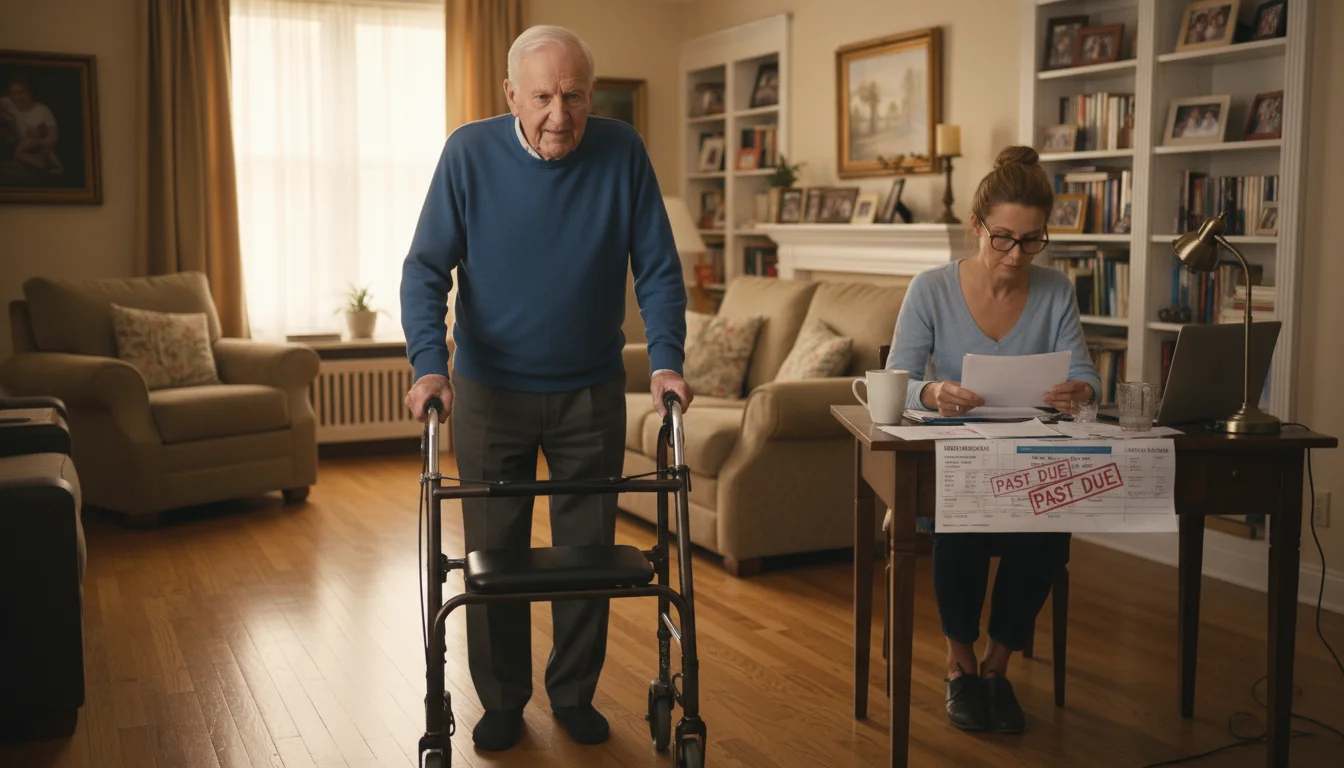Becoming a caregiver for a spouse, partner, or parent is one of the most profound acts of love and commitment. It is a journey you undertake with your heart, but it is one that deeply involves your wallet as well. While focusing on your loved one’s health and comfort is your top priority, ignoring the financial side of this new role can lead to immense stress and instability for you both.
The financial impact of caregiving can be sudden and overwhelming, especially for seniors on a fixed income. This guide is designed to be your roadmap. We will walk you through the essential steps to understand and manage the costs of caregiving, organize your finances, find help, and most importantly, protect your own financial well-being through this challenging time. You are not alone, and with a clear plan, you can navigate this journey with confidence and peace of mind.
This article is for informational purposes only and is not intended to be financial advice. Please consult with a qualified financial professional for advice tailored to your individual situation.

First, Take a Financial Snapshot: Know Where You Stand
Before you can make any decisions, you need a clear picture of your complete financial situation. This isn’t about judging past spending; it’s about creating a factual starting point. Taking this step can feel daunting, but getting organized is the single most powerful thing you can do to reduce financial anxiety.
Why this is important: On a fixed income, every dollar counts. A clear financial snapshot helps you see exactly where the money is coming from and where it’s going. This allows you to identify potential shortfalls, plan for upcoming senior caregiving expenses, and make informed decisions instead of emotional ones during a crisis.
How to do it:

Understanding the Real Caregiving Costs
Many people mistakenly believe that the only new expenses will be medical co-pays. In reality, the true caregiving costs are much broader and can quickly add up. Anticipating these expenses helps you budget for them and seek help before your savings are depleted.
Why this is important: Hidden costs are what often derail a caregiver’s finances. By understanding the full spectrum of potential senior caregiving expenses, you can create a more realistic budget and avoid being caught off guard by a large, unexpected bill.
How to categorize the costs:

Direct Medical and Support Costs
- Medical Expenses: This includes insurance deductibles, co-pays for doctor visits, prescription drug costs (especially those in the Medicare “donut hole”), and therapies not fully covered by insurance.
- Medical Equipment: Your loved one may need items like a walker, hospital bed, oxygen machine, or hearing aids. While insurance may cover some of these, you often have to pay a portion out-of-pocket.
- Home Modifications: To ensure safety, you might need to install grab bars in the bathroom, build a wheelchair ramp, or even install a stairlift. These modifications can range from hundreds to thousands of dollars.
- Professional In-Home Care: If you need help from a home health aide for bathing, dressing, or medical tasks, this is often a significant recurring expense. Adult day care is another option that provides a safe environment for your loved one while giving you a needed break.

Indirect or “Hidden” Costs
- Higher Household Bills: Having someone at home all day often means higher electricity, heating, and water bills. You may also spend more on groceries, especially if special dietary needs are involved.
- Transportation: You will likely be driving more for appointments with doctors, specialists, and pharmacies. The cost of gas and vehicle maintenance can increase noticeably.
- Your Own Health: The stress of caregiving can take a toll on your physical and mental health. Neglecting your own check-ups or wellness to save time and money can lead to much larger costs for you down the road.

Organizing Legal and Financial Documents: A Critical Step
When a health crisis strikes, the last thing you want is a legal or administrative roadblock preventing you from helping your loved one. Having the right legal documents in place before they are needed is essential for smooth and effective family financial planning.
Why this is important: Without the proper legal authority, banks, hospitals, and insurance companies may refuse to speak with you. This can prevent you from paying bills from your spouse’s account, making medical decisions on their behalf, or managing their assets to pay for care. Getting this organized provides peace of mind and prevents legal chaos.
How to get organized:
- Locate and Secure Key Documents: Work with your loved one to find their essential papers. Create a binder or a secure file that includes their will, any trust documents, birth certificate, Social Security and Medicare cards, and all insurance policies (life, health, long-term care, home).
- Ensure You Have Power of Attorney (POA): This is one of the most important documents. A Durable Power of Attorney for Finances allows you to manage their financial affairs (like paying bills or selling assets for their care) if they become unable to do so. A Power of Attorney for Healthcare (also called a healthcare proxy) allows you to make medical decisions on their behalf based on their wishes.
- Discuss a Living Will: A living will, or advance directive, is a document that outlines their wishes for end-of-life medical care. This relieves you of the burden of guessing what they would have wanted in a difficult situation.
- Create a Master Contact List: Compile a list of important phone numbers and contacts. This should include their doctors, lawyer, accountant, insurance agent, and any financial advisors. Keep a securely stored list of online account usernames and passwords as well.

Tapping into Resources to Manage Caregiver Finances
You do not have to bear the entire financial burden of caregiving on your own. There is a network of public and private programs designed to help ease the load. The key is knowing where to look.
Why this is important: Using available benefits can save you thousands of dollars, preserving your retirement savings for your own future. These programs can provide direct financial assistance, cover the cost of care, or offer services that give you a much-needed break.
Where to find help:
- Medicare and Medicaid: It’s crucial to understand what they do and do not cover. Medicare generally covers short-term, skilled nursing care after a qualifying hospital stay, but it does not pay for long-term “custodial” care (help with daily activities like bathing or dressing). Medicaid, a program for low-income individuals, can cover long-term care, but it has very strict income and asset limits.
- Veterans Affairs (VA) Benefits: If your loved one is a veteran, they may be eligible for benefits. The “Aid and Attendance” pension, for example, provides a monthly payment to veterans or their surviving spouses who need help with daily activities.
- Your Local Area Agency on Aging (AAA): This should be one of your first calls. AAAs are a nationwide network of organizations that serve as a single point of entry for senior services. They can connect you with local programs for meal delivery (like Meals on Wheels), transportation, respite care (temporary relief for caregivers), and information on local benefits.
- Long-Term Care Insurance: Check your documents to see if you or your loved one ever purchased a long-term care insurance policy. If so, review it carefully to understand what benefits it provides and how to file a claim.
- Disease-Specific Organizations: Non-profits like the Alzheimer’s Association, the American Cancer Society, and the Parkinson’s Foundation often provide grants, resources, and support services for patients and their families.

Protecting Your Own Financial Future
In your mission to care for your loved one, it is natural to want to do everything you can, including spending your own money. However, you must remember the old airline safety rule: put on your own oxygen mask first before helping others. Jeopardizing your own financial security will not help your loved one in the long run.
Why this is important: If you deplete your own retirement savings, you risk creating a second financial crisis down the road—your own. Protecting your assets ensures you can remain a stable and effective caregiver and that you will be financially secure in your own later years.
How to protect yourself:
- Establish Clear Financial Boundaries: It is noble to want to help, but you should not liquidate your own IRA or 401(k) to pay for care. These accounts are for your retirement. A financial advisor can help you create a sustainable plan that uses your loved one’s assets first.
- Avoid Co-mingling Funds: Keep your finances separate from your loved one’s. Pay their bills from their accounts using the authority granted by a Power of Attorney. Mixing funds can create legal confusion and may jeopardize their eligibility for programs like Medicaid.
- Account for Your Time and Expenses: If you are managing your loved one’s estate, keep meticulous records of any of your own money you spend on their behalf so you can be reimbursed from their assets. In some cases, a formal caregiving agreement can be created that allows you to be paid a small stipend for your work, but this should always be done with guidance from an elder law attorney.
- Accept Help to Avoid Burnout: Caregiver burnout is real, and it can lead to costly health problems for you. Accept offers of help from friends and family. Use respite care services to give yourself a break. Your well-being is a critical component of your caregiver finances.

Conclusion: A Path Forward with Confidence
The financial journey of caregiving is complex, but it is not impossible to navigate. By taking a clear look at your finances, understanding the full scope of the costs, getting your legal documents in order, and tapping into every available resource, you can create a stable foundation for this new chapter of life.
Remember to be kind to yourself. You are managing an enormous emotional and practical challenge. Taking these structured, deliberate steps to manage caregiver finances is not selfish—it is responsible. It is the best way to ensure you can provide loving, sustainable care for your loved one while also protecting the financial security you have worked a lifetime to build.
For expert guidance on senior health and finance, visit Centers for Disease Control and Prevention (CDC), Medicare.gov, National Institute of Mental Health (NIMH), National Institutes of Health (NIH) and Centers for Medicare & Medicaid Services (CMS).
|
Fact-Checked Content
Our editorial team reviews all content for accuracy and updates it regularly. Learn about our editorial process →
|


















